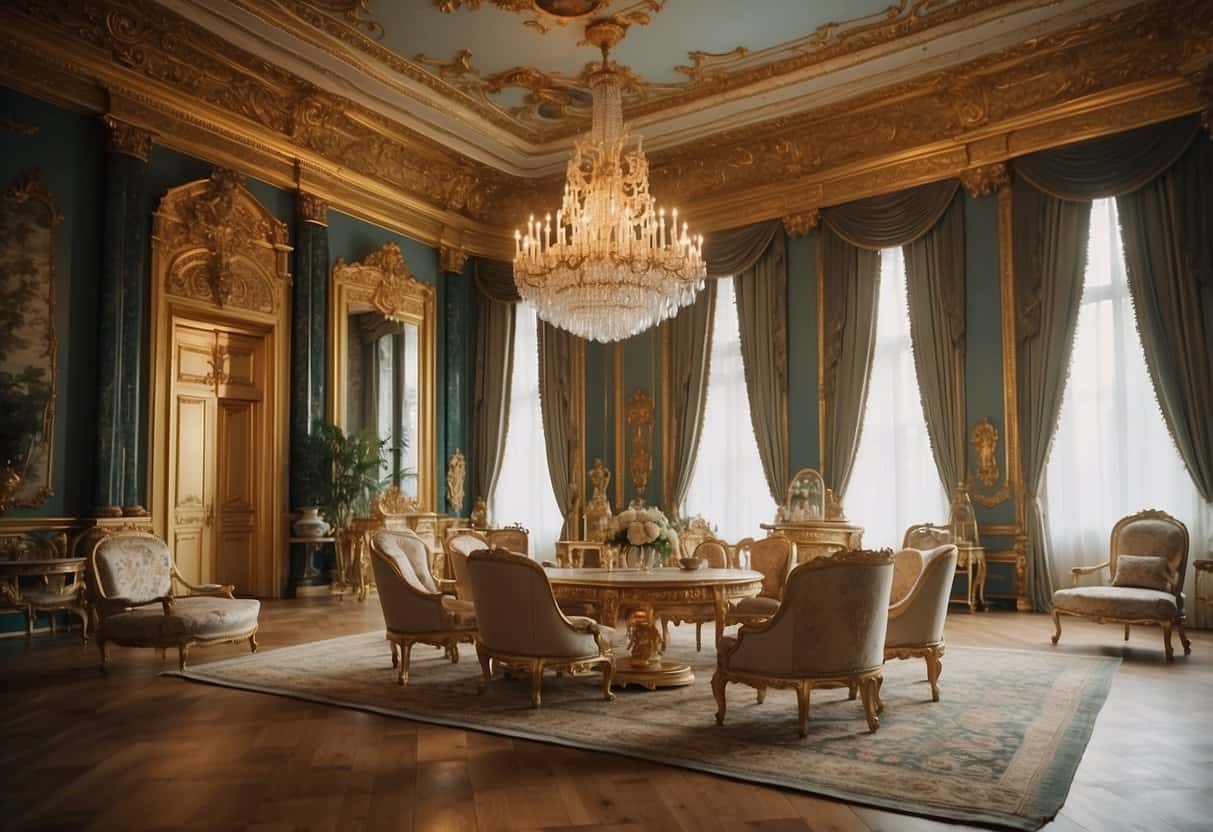Catherine the Great’s furniture tells us a lot about her tastes, era, and personality. Known as one of Russia’s most powerful and influential rulers, Catherine II, or Catherine the Great, was an Empress who expanded her empire and brought a wave of European culture and sophistication to Russia. Her reign marked a golden age of Russian art, culture, and architecture. The furniture associated with Catherine the Great reflects her unique style, European influences, and her ambition to make Russia a cultural powerhouse.
In this article, we’ll dive deep into Catherine the Great’s furniture, exploring its design, historical context, and lasting legacy. Join us as we journey through the intricate world of Russian imperial furnishings, learning what made her furniture so distinctive and why it still fascinates historians and art lovers alike.
The European Influence on Catherine the Great’s Furniture
Catherine the Great’s furniture was heavily influenced by European styles, particularly from France, Italy, and England. Born as a German princess, Catherine had strong ties to European culture, and she admired the elegance and sophistication of Western European furniture design. When she became Empress of Russia, she brought these tastes with her, transforming Russian interior design and art.
Why European Influence?
Catherine’s admiration for Enlightenment ideals and European artistry inspired her to model her court’s furnishings after those found in royal palaces across Europe. She believed that embracing European styles would help modernize Russia and elevate its status on the world stage. Thus, she invited foreign artisans to Russia, bringing with them techniques and styles that shaped “Catherine the Great’s furniture” in significant ways.
Key Styles in Catherine the Great’s Furniture
During Catherine’s reign, furniture styles in Russia went through various transformations. Here’s a closer look at some of the main styles that defined Catherine the Great’s furniture:
- Baroque Style: Early in her reign, Baroque-style furniture was popular. This style is characterized by its opulence, dramatic details, and heavy ornamentation.
- Rococo Influence: Catherine loved the Rococo style, known for its playful curves, intricate patterns, and use of pastel colors. Rococo furniture often featured elaborate decorations, light colors, and gilded details, all of which appealed to Catherine’s refined tastes.
- Neoclassicism: Toward the latter part of her rule, Neoclassical furniture became the dominant style. Neoclassicism focuses on symmetry, simple lines, and inspiration from ancient Greece and Rome. Catherine’s shift to Neoclassicism symbolized her appreciation for rationality and order, qualities associated with the Enlightenment.
Each of these styles brought its own charm to Catherine’s palaces, making her furniture collection a fascinating blend of artistic movements.
Materials Used in Catherine the Great’s Furniture
The materials used in Catherine the Great’s furniture were as luxurious as the designs themselves. She spared no expense in obtaining the finest resources available at the time. Some of the most notable materials include:
- Exotic Woods: Woods like mahogany, rosewood, and ebony were often used. These woods were imported from far-off lands, symbolizing wealth and sophistication.
- Gilded Bronze and Gold Leaf: Catherine’s furniture often featured gilded bronze accents or gold leaf decorations, giving her pieces a regal and eye-catching finish.
- Porcelain and Lacquer: Imported from China and Japan, porcelain and lacquer were used for decorative elements, adding an exotic flair to the furnishings.
- Fine Fabrics: Upholstered pieces were often covered in luxurious fabrics like silk, velvet, and damask, with intricate embroidery and patterns.
These materials not only made her furniture visually stunning but also demonstrated the wealth and grandeur of the Russian Empire under Catherine’s rule.
Famous Pieces in Catherine the Great’s Collection
Catherine the Great was known for her lavish spending on art and furniture. Some of her most famous pieces are still preserved today, serving as reminders of her exquisite taste. Here are a few iconic examples of “Catherine the Great’s furniture”:
The Malachite Room
Catherine had a deep fascination with the green semi-precious stone malachite. Known as the “Malachite Room,” one of her chambers in the Winter Palace featured walls, columns, and even furniture adorned with this stone. Malachite was rare and incredibly expensive, and using it in furniture signified her immense wealth and ambition to showcase Russian resources.
The Arabesque Study
In her private quarters, Catherine had an “Arabesque Study,” a room filled with unique furnishings inspired by Middle Eastern design. This room featured furniture pieces decorated with intricate arabesque patterns, gold leaf, and beautifully carved details. It was one of her favorite retreats and served as a symbol of her openness to diverse cultural influences.
The Amber Room
Perhaps the most famous example of Catherine the Great’s furniture is not a piece of furniture at all but an entire room—the Amber Room. This room, originally a gift from the Prussian king, was adorned with amber panels, mirrors, and gold leaf, creating a breathtaking display of luxury. Catherine had the Amber Room installed in the Catherine Palace, and it became one of the most iconic symbols of her reign.
Unique Design Features in Catherine the Great’s Furniture
What made Catherine the Great’s furniture so unique were the design elements that set it apart from typical European furnishings. Here’s a look at some distinguishing characteristics:
- Ornate Carvings: Many pieces featured intricate carvings, particularly in the Rococo and Baroque styles, with floral motifs, scrolls, and mythical creatures.
- Gold and Silver Inlays: Catherine’s furniture often included precious metal inlays, adding an extra level of opulence.
- Use of Mirrors: Mirrors were used extensively, not just for practical purposes but also to create an illusion of spaciousness and grandeur in her rooms.
- Elegant Curves and Flourishes: From chairs to tables, her furniture often had smooth, flowing curves, a hallmark of the Rococo style, lending a sense of lightness and grace.
- Personal Monograms and Symbols: Some pieces included Catherine’s monogram or the imperial double-headed eagle, a symbol of Russian royalty, emphasizing her power and influence.
These elements gave her furniture an aura of extravagance, reflecting her desire to build a legacy of imperial splendor.
Artisans Behind Catherine the Great’s Furniture
Catherine did not create her furniture on her own, of course. She commissioned some of the finest craftsmen of her time, both Russian and foreign, to make her pieces. Here are a few notable artisans associated with Catherine the Great’s furniture:
- Georg Friedrich Tarsch: A German-born cabinetmaker who was brought to Russia by Catherine. Tarsch specialized in Rococo furniture and crafted several pieces for the royal palaces.
- Charles Cameron: A Scottish architect and designer, Cameron introduced the Neoclassical style to Russia. Catherine admired his work, and he designed many interiors and furniture pieces for her, especially at the Tsarskoye Selo.
- Vasily Bazhenov: A Russian architect and designer, Bazhenov was instrumental in blending European influences with traditional Russian styles, creating pieces that uniquely reflected Catherine’s taste.
These artisans helped bring Catherine’s vision to life, combining their expertise with her vision of a culturally refined Russian Empire.
The Legacy of Catherine the Great’s Furniture
Catherine the Great’s furniture didn’t just serve as decoration—it was a statement of her vision for Russia. By blending Russian traditions with European styles, she aimed to make Russia an intellectual and cultural hub. Her taste in furniture set trends that would influence Russian aristocracy for generations.
Today, many of her furniture pieces remain preserved in Russian museums, including the Hermitage Museum in Saint Petersburg. Her legacy also continues through reproductions of her designs and the inspiration her style provides for modern furniture makers. Catherine’s vision of luxury, elegance, and sophistication lives on, symbolizing a pivotal era in Russian history.
Table: Key Materials and Their Significance
| Material | Description | Significance |
|---|---|---|
| Exotic Woods | Mahogany, rosewood, ebony | Symbolized wealth and exotic appeal |
| Gilded Bronze | Bronze coated with a layer of gold | Added a royal touch, often used in decoration |
| Malachite | Green semi-precious stone | Showcased Russia’s natural resources |
| Fine Fabrics | Silk, velvet, damask | Provided a luxurious and comfortable finish |
| Porcelain & Lacquer | Imported materials from Asia | Showed global influence and appreciation for art |
The Continued Fascination with Catherine the Great’s Furniture
So, why does “Catherine the Great’s furniture” continue to captivate us? It’s more than just beautiful furniture; it’s a window into the life of an extraordinary woman who reshaped her country and left an indelible mark on history. Her furniture collection tells stories of ambition, taste, and cross-cultural appreciation. It reveals her desire to align Russia with Europe while still highlighting her empire’s unique identity.
To this day, people flock to museums and exhibitions to catch a glimpse of her opulent furniture. Designers and historians alike draw inspiration from her collection, keeping her legacy alive. Catherine the Great’s furniture stands as a testament to her vision and a reminder of a time when art and royalty were deeply intertwined.




